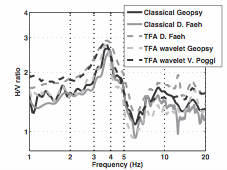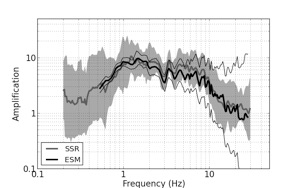Strong Motions and site effects

Challenges
Effect of surface geology on strong motions is a critical part of seismic hazard and risk assessment. It is mainly due to S-wave velocity variations near the surface. Extensive data of S-wave velocity in depth is lacking in order to work at the regional scale. Moreover, other effects than 1D structure affect the ground motion amplification such as 2D/3D resonances. Techniques to track and systematically model this kind of resonances are still lacking.
In order to harvest earthquake data, modern strong motion (accelerometric) stations are sensitive, real-time and continuous. Therefore their position should be a trade-off between the scientific objectives (e.g. representative recordings for a city) and technical issues such as being able to record also small earthquakes.

The Swiss Seismological Service is currently renewing his strong motion network (SSMNet). 30 new were installed in 3 years (2010-2013) following the most up-to-date standards. I was in charge of coordinating this first phase of the project on behalf of Prof. D. Fäh, selecting and characterizing the sites for these new stations and coordinating their installation. The success of this first phase lead to the funding of a second phase including 70 more stations.
The objective of site characterization is to estimate the geometry (layering) and physical parameters (especially the shear wave velocity) of the ground. Using existing method based on ambient vibration recordings (single station, arrays) as well as developing new methods is crucial to understand the uncertainty on our knowledge of the ground structure. We collected a large amount of data and structured it in a database. 2D/3D effects are systemically tracked. Proxies (from models and observations) to estimate the amplification with respect to reference rock are also compared.
Besides this, I am interested in instrumenting civil engineering structures in Switzerland in the frame of the SSMNet. SSMNet is already leading in the instrumentation of large dams as supported by international publications on data on Emosson or Mauvoisin dams. However, no building is currently instrumented in Switzerland. Therefore, I am supporting the idea of instrumenting typical buildings in the highest seismicity zones of the country.
what it is
Objectives
-
•Optimization of the location of strong motion stations
-
•Site characterization
-
•Effect of surface geology on ground motion
-
•Monitoring of civil engineering structures
Main research axes
-
•Ground ambient vibrations on long time series
-
•Site characterisation using ambient vibrations (single stations, arrays...) and complementary means (boreholes, active seismic...)
-
•Proxies for site amplification
Project
SSMNet renewal project
Earthquake Mitigation project in Basel City.
LINKS
RELATED PUBLICATIONS
Summary publication: “Assessment of site effects in Alpine regions through systematic site characterization of seismic stations”
“Earthquakes in Switzerland and surrounding regions during 2013“
“Earthquakes in Switzerland and surrounding regions during 2012“
“The Current State of Strong Motion Monitoring in Switzerland”, Earthquake data in engineering seismology: networks, data management and predictive models

